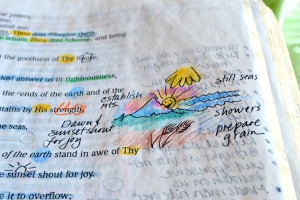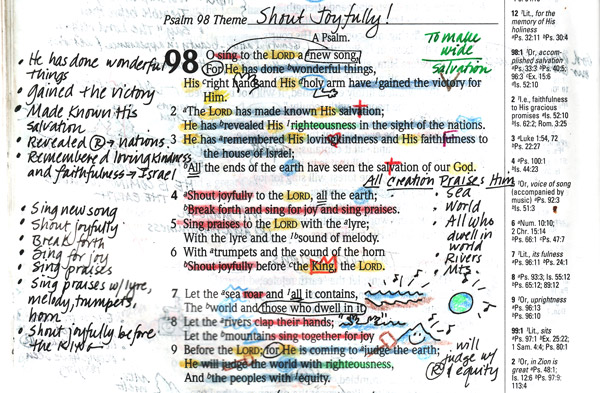How many of us struggle with reading the Bible on a regular basis? We know we should do it. We know God speaks to us through His Word. We commit and re-commit to reading our Bibles each day, and then we find ourselves not doing it again.
 Marking in my Bible helps me pay attention to what I am reading. Marking in my Bible gets me actively engaged with the text, which helps my mind not wander. And the more I mark, the more excited I get about what I’m learning, which makes me excited about reading my Bible.
Marking in my Bible helps me pay attention to what I am reading. Marking in my Bible gets me actively engaged with the text, which helps my mind not wander. And the more I mark, the more excited I get about what I’m learning, which makes me excited about reading my Bible.
Susannah posted some pictures of my old study Bible last week. Those pictures were all from the Psalms. I aggressively studied and prayed the Psalms during an especially challenging time in my life, and continue to turn to them over and over again for comfort and strength. Our children were small at the time I marked the pages in that Bible. I found that physically engaging with the text helped me concentrate better, and, as a bonus, it also aroused quite a bit of interest from my children as they came and went while I read.
I would like to explain what some of those marks were for, with the hope that some of you might find this helpful in your own Bible study. Different study methods work for different people, and people may use different methods during different periods of their lives. I don’t always mark this extensively. I’ve been reading from a smaller Bible, in a different translation, which leaves much less room for marking and writing notes. But I think it might be a good idea to do some of my studying in this Bible again. Marking really helps me slow down and “chew” on what I’m reading.
Let’s look at Psalm 98 together. If you would like to try out this approach to studying the Psalm, grab your Bible, some colored pencils, and a fine-point pen, and join me!

- First thing to do whenever we read God’s Word is to pray for guidance. We won’t understand what we read without the Holy Spirit’s help.
- I start by simply reading the entire Psalm. This helps me get the overall message without being distracted by looking for specific words or changing back and forth between different colored pencils.
- Then I read again looking for references to God. I marked those with a yellow pencil, and marked His actions with blue – what He has done, what He is doing, what He will do.
- Then I read again, marking in red all instructions and commands to the reader.
- Next reading, I marked other things that I wanted to note. Marking words in this way has always helped me see recurring themes and patterns in a passage. I choose colors that I can associate easily with particular words. Your choices may differ from mine.
-
- References to righteous, upright, blameless, etc. get marked with green. (If the wicked were mentioned in this passage, I would mark those words with a black “W”. I chose green for righteousness because it makes me think of the righteous man who is like a tree planted by the water in Psalm 1.)
- References to world, earth, creation get marked with a solid blue circle. (I associate that with the photos of our blue earth in space.)
- The word king and other references to royalty get marked with an orange crown. (The orange makes me think of gold.)
- Parts of the body are usually illustrated with simple line drawings (i.e. the hand and arm in this Psalm).
- References to the cross, salvation, etc. are marked with a red cross. (Red makes me think of the blood that was shed for our salvation.)
- References to judge and judgment are noted with a little drawing of a gavel.
- Love, lovingkindness, and other references related to love are marked with a red heart.
- I double-underlined the word all. This often proves to be a useful word to pay attention to as I read.
- I circled words like for, therefore, because. These words link the words that come before them with the thoughts that follow them. Circling the words helps me pay attention and make those connections.
- I added illustrations because they help me remember the text better, they help me think longer about some of the word pictures in Scripture, they helped me explain what I was reading to my children when they were younger, and they help me recall what I’ve learned as I glance at a page again. (And besides all these reasons, they’re just fun to draw. :-)) The colors in the drawings correspond with the colors I use to mark words. For instance, if I’m drawing a hand that is supposed to represent God, I color it yellow, just like I mark words about God with yellow.
- I summarized some of what I observed in the Psalm by making lists in the margins. In this Psalm, I listed: (1.) What God had done, (2.) What we are told to do (i.e., what am I supposed to do?), and (3.) The different things in creation that are praising Him. Different passages will inspire different lists.
- I finished my study by rereading the Psalm, thinking about my observations, and praying for God to help me put what I have learned into action. Another day, I might reread the Psalm again, and read a commentary such as Spurgeon’s Treasury of David that discusses the Psalm.
What will help you think harder about what you are reading? What marks or pictures will help, rather than distract, you as you read? You can come up with your own marking system. Note your symbols and marking methods on a 3 x 5 card you keep in your Bible for easy reference.
If you can’t bring yourself to mark up your Bible, print out the passage you want to study. Double-space the text and leave lots of room on the page for notes. Put it in a notebook and mark away! I personally think it’s really nice to have a Bible with all my own personal markings and drawings in it — kind of like my own “illuminated” Bible. 🙂 I have printed out portions to mark, but they are not nearly as easy to pull out and review as the ones in my Bible.
 The Bible in the above photo is the International Inductive Study Bible
The Bible in the above photo is the International Inductive Study Bible. The version I own was published by Harvest House in 1993. It has nice big margins for notes, and nice big print, which leaves more space for marking the text. The big print was also nice when my little guys were looking over my shoulder. A newer hardback edition is also available. It is smaller (the 1993 edition is a big 7-1/2″ x 9-1/2″ x 2″) and costs less than the 1993 edition, but it does have smaller margins and smaller type.
Each book in this Bible is preceded by some historical background and suggestions for ways to approach the text – key words to watch for, things to think about, themes to observe. The notes are designed to help you study the Bible for yourself. This is the Bible that really got me excited about studying the Bible!)
The colored pencils I use are my jumbled collection of Prismacolor soft core (Premier) and Spectracolor colored pencils. Be sure you don’t buy Prismacolor Verithin pencils. They are hard lead, which will not work well. The soft lead pencils easily mark thin Bible pages without marring them, and the colors are rich and vibrant. They’re a bit expensive, but you don’t need a big set, and they’re well worth the cost. The colors of cheap pencils are hard to see, and the pencils damage the fragile paper in most Bibles. If you’re trying to study while the children are up, put your box of pencils out where they can reach them, set out a couple inexpensive, but good quality Dover coloring books, and share your pencils while you study. Or get brave and let the kids draw some simple illustrations in your Bible along with you!)
Use a fine or micro-point pen for writing words and drawing little pictures. My favorite is a Uniball Micro Point roller ball pen. The ink does occasionally show through the page a bit. If that bothers you, keep experimenting until you find a pen you like. Ball point pens don’t show through as much, but I like the darker, sharp lines of the roller ball pen.
Additional resources
 Since writing this post, I’ve started to host thirty-day studies on this blog for busy ladies who want to make time for serious Bible study. You can find our past studies in the blog archive, or subscribe to my blog updates to be notified when we start the next study.
Since writing this post, I’ve started to host thirty-day studies on this blog for busy ladies who want to make time for serious Bible study. You can find our past studies in the blog archive, or subscribe to my blog updates to be notified when we start the next study.
For your convenience, four of these Bible studies are available in book form and on Amazon Kindle, with more coming soon. Doorposts also offers a “Busy Mamas Bible Study Kit” with all the materials you need to start studying.
This post contains affiliate links.

15 Trackbacks